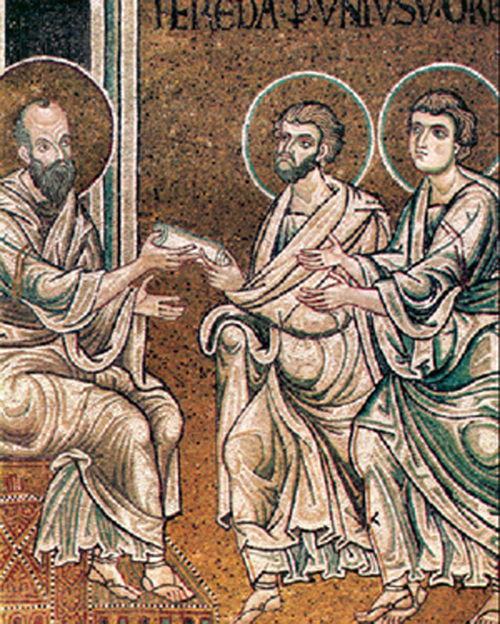Armanda Santos, FSP, 12/06/2017
This greeting is written with my own hand— Paul ’s
This is my sign in every letter, this is how I write.
2 Thessalonians 3:17
An icon is a receptacle for content; in looking at an image, we do not simply see an object but we also associate some meaning to it. For example, in the mosaic St. Paul with Timothy and Silas, we see Paul sitting on a throne-like chair. Because being seated in a chair traditionally denotes authority, we immediately associate this image with Paul’s teaching authority.
In this mosaic the unknown artist, whose work dates from between the twelfth and thirteenth centuries, has employed a technique common in Eastern iconography to express Paul’s knowledge and wisdom— that is, portraying his forehead as high, broad, and furrowed. While the Apostle is in the process of handing a papyrus scroll to his disciple Silas, the second disciple in the image, Timothy — distinguished by his youthful, beardless face — stretches out his hand in the gesture of receiving. Here the artist is recalling for us the letters Paul wrote to the Christian communities and their importance for the Church. Paul himself insists that what he writes is truly the word of God, for he knows the mind of Christ (cf. 1 Cor 2:16). The Pauline letters, among the earliest writings of the New Testament, remain relevant for our times, for the word they proclaim addresses universal themes with which Christians today can identify.
The New Testament attributes thirteen letters to Paul. Of these, scholars consider seven to be of undisputed authorship because they reflect a similar theology, perspective, and vocabulary. The other six differ from the undisputed letters on certain eschatological aspects, writing styles, and theologies that may reflect a later Church with a more developed structure.
Paul’s letters appear in the biblical canon not in the order in which they were written but in order of their length, beginning with Romans, the longest letter, and ending with Philemon, the shortest. One way to study St. Paul is to read the letters in chronological order, from the earliest written to the latest. One possible chronological arrangement of the letters is: 1 Thessalonians (A.D. 49–51), Galatians (52–54.), 1 and 2 Corinthians (52–54, 55), Romans (54–55.), Philippians (58–60), and Philemon (58–60), followed by the deutero-Pauline letters: 2 Thessalonians, Colossians, Ephesians, 2 Timothy, 1 Timothy, and Titus.
It is important to remember that both the Acts of the Apostles and the deutero-Pauline letters continue to have great value for the insight they provide into the Apostle’s person and mission. Whether or not written by Paul, the letters of disputed authorship reflect his influence and show the development of his teaching. These writings, individually and taken as a whole, enrich our understanding and appreciation of the Apostle Paul.
How did Paul go about the task of writing his letters to the Christian churches? In New Testament times much of the writing was done on papyrus, from a plant native to the swamps of Egypt. The leaves of this plant were laboriously processed into paper. A writing instrument would be fashioned from a piece of cane sharpened to a point and partly split at the tip. This reed, when dipped in ink, became a pen, the conventional tool for writing in Paul’s time.
Professional secretaries were in demand in antiquity; correspondence was generally entrusted to scribes, who functioned as an extension of the sender in their capacity as writers, editors, record keepers, and stenographers. Paul would have followed this arrangement when writing his letters. Although dictated, they were still his letters in every way, for he was the author whose thoughts, reflections, and teachings were being transcribed.
The most direct proof that Paul used dictation is found in the Letter to the Romans, where the presence of a secretary is indicated in the conclusion of the letter: “Tertius, the writer of this letter, greets you in the Lord” (Rom 16:22). While this is the only time a letter writer is named, the role of scribes who took dictation or edited the letters is alluded to in other places:
“This greeting is written with my own hand—Paul’s. This is my sign in every letter, this is how I write” (2 Thes 3:17).
“Look how large the letters are that I’m writing to you with my own hand!” (Gal 6:11).
“This greeting is my own writing— Paul’s” (1 Cor 16:21).
In each of these instances, the insistence of certain words of greeting written in Paul’s “own hand” implies that the rest of the text was written by the hand of another— namely, a secretary.
Paul was certainly capable of writing his own correspondence, but apart from the fact that first-century norms prescribed the use of professional scribes, Paul, with his quick, clever, and creative mind, would have benefited greatly from a secretary who could keep pace with the Apostle as he brilliantly expounded his message. Some of the Pauline letters also mention co-senders who perhaps, along with Paul, contributed to the content. Such examples are noticed in the letters to the Thessalonians, Corinthians and Philippians:
“Paul, an apostle of Christ Jesus by the will of God, and Timothy our brother to the church of God in Corinth . . . ” (2 Cor 1:1).
“Paul, Silvanus, and Timothy to the church of the Thessalonians . . . ” (1 and 2 Thes 1:1).
“Paul, called by the will of God to be an apostle of Christ Jesus, and our brother Sosthenes, to the church of God in Corinth . . . ” (1 Cor 1:1).
Paul’s style of writing is intimate and personally revealing; these letters emanate from the heart of one who is sharing with beloved brothers and sisters what he has experienced, lived, heard, seen, and felt. The letters are encouraging and pastoral in content, alternately urging, exhorting, responding to hearsay, correcting, advising, and comforting.
After having established or helped to lay the foundation for the various Christian churches, Paul has yet another opportunity to proclaim through his writings the gospel of God’s faithful love. Structured in a format common to his time, the letters open with a greeting and thanksgiving, continue with the main message, and culminate in final salutations and concluding remarks. These pastoral messages were meant to be read aloud in the local assemblies that gathered together on the Lord’s Day. The public reading ensured that all the Christians in the area were present to hear words addressed to the whole community.
Paul wrote letters to speak for him in his absence. Always focused on his children’s formation in the faith, he takes every opportunity for “building up of the body of Christ” (Eph 4:12). He goes so far as to declare: “You are our letter, written on our hearts, for all to know and read. Yes, you’re clearly a letter from Christ delivered by us, written not with ink but with the Spirit of the living God, not on stone tablets but on tablets of human hearts” (2 Cor 3:2–3).
Because Paul sometimes writes in direct response to queries previously posed to him, and we only have his answers without the questions themselves, it may sometimes seem as if we are reading one-sided conversations. The consequence of Paul’s letters not being heard in their full context may result in the reader’s misunderstanding or a harsh judgment for certain comments Paul makes. We may even want to agree with the author of 2 Peter when he writes: “. . . [O]ur beloved brother Paul wrote to you with the wisdom he has been given. . . . There are some things in his letters which are difficult to understand . . . ” (2 Pet 3:15, 16). Yet by committing time and other resources to the great adventure of reading and studying Paul’s writings, availing ourselves of the abundant commentaries available on every aspect of his work, we will better understand Paul’s heart and, through that prism, welcome his words and teaching for the richness they contain.
Armanda Santos, FSP, a Daughter of St Paul, is Director of Field Education for St Patrick's Seminary, Menlo Park, California.
About the image:
Artist unknown. St. Paul with Timothy and Silas (twelfth- or thirteenth-century mosaic).
Courtesy of Duomo of Monreale, Palermo, Italy.













